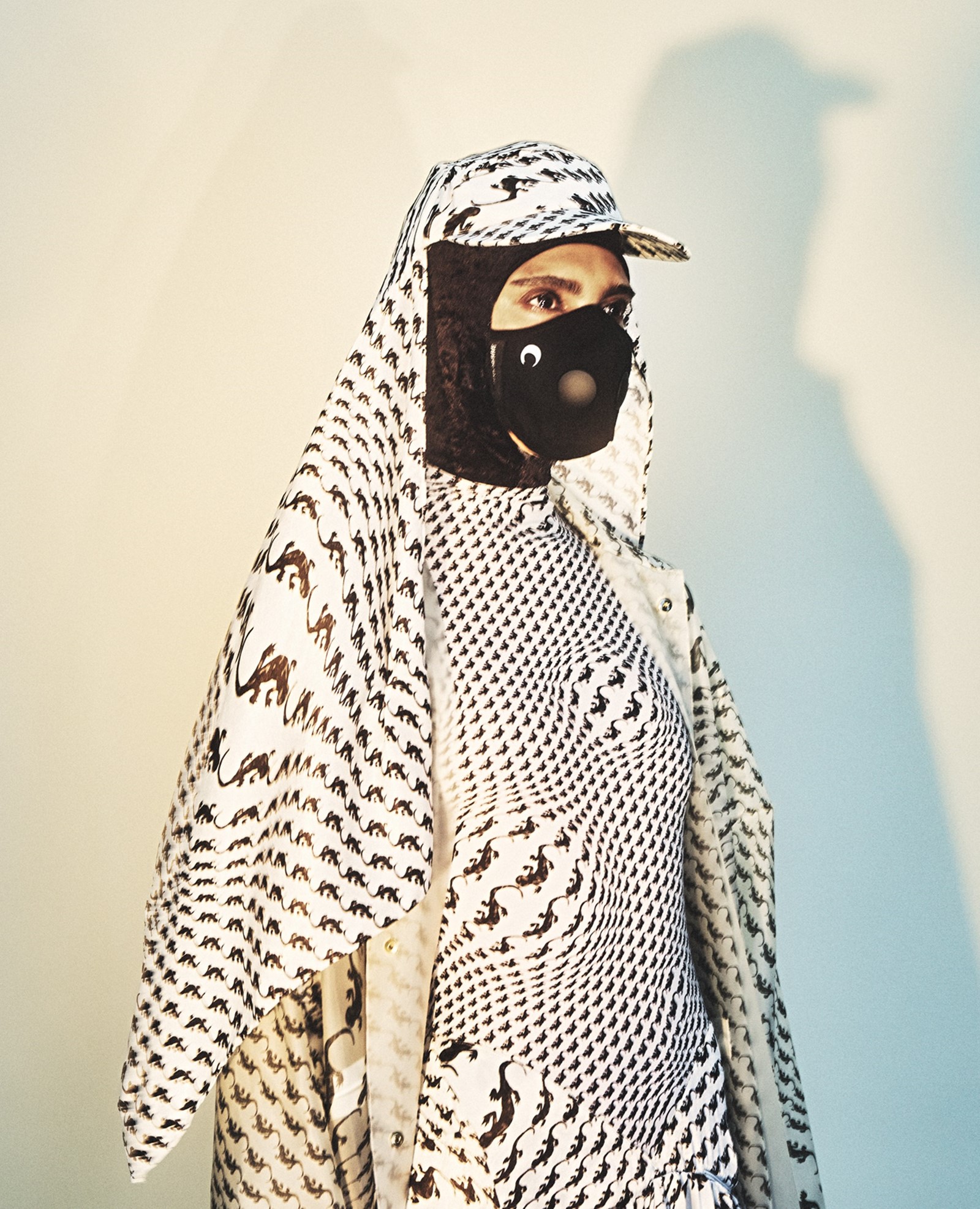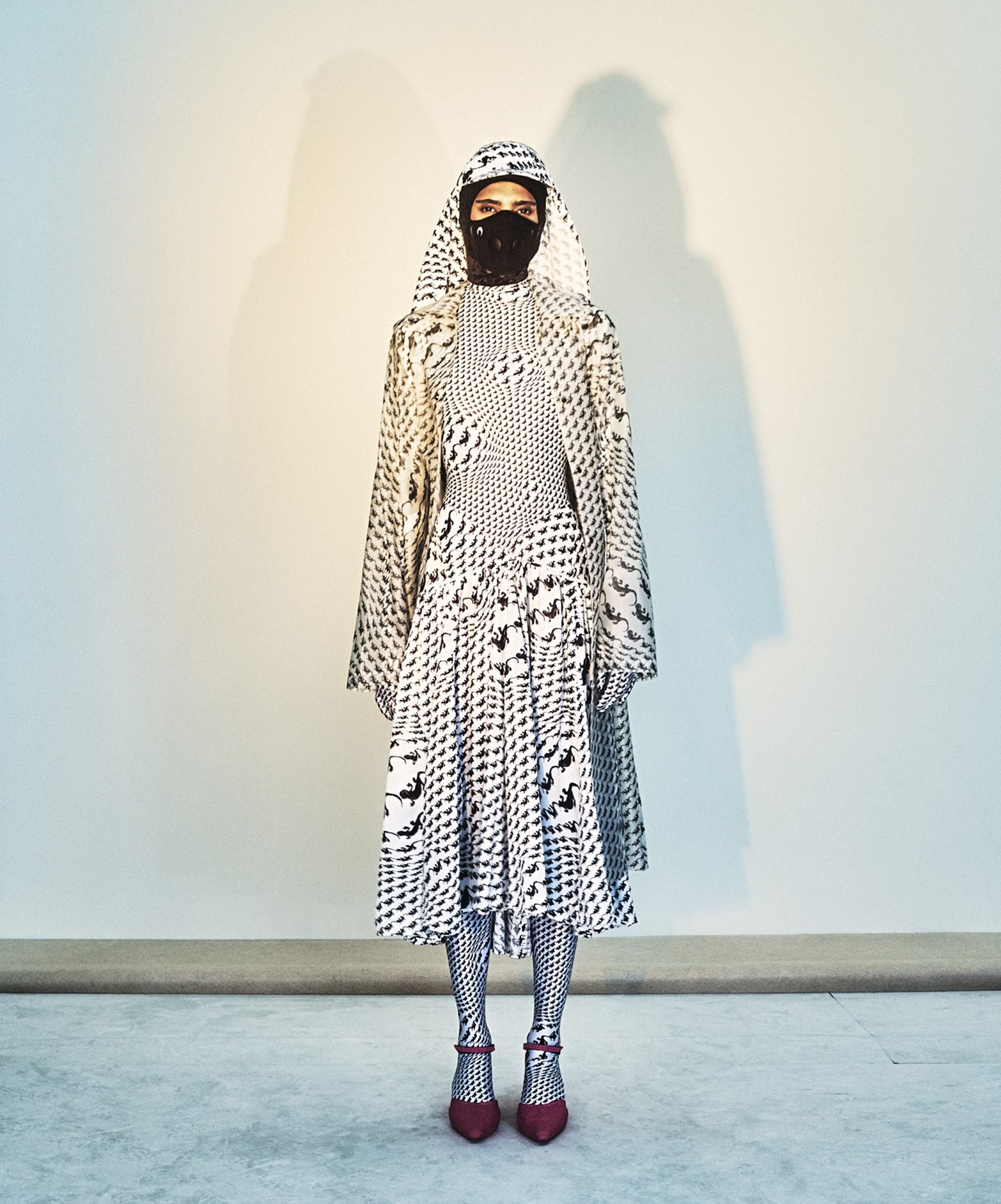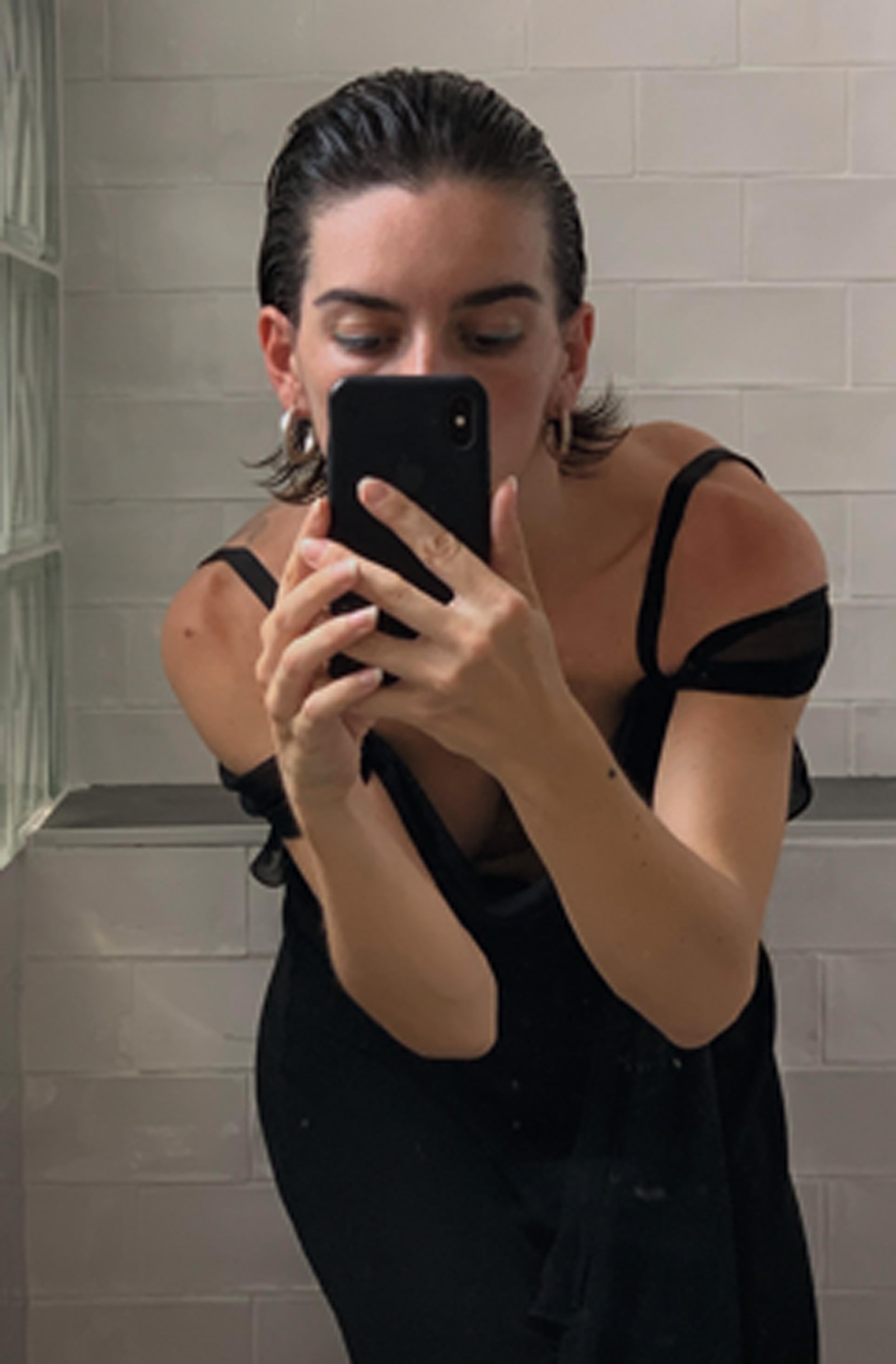The word most often used to describe Marine Serre’s designs is “dystopian”. That’s what a vision of the future seems like when artifice meets reality, when bodies are smothered in fabric as if to protect them from toxic elements, when faces are masked and when ‘couture’ is made from society’s detritus, from cast-off keychains and fleece blankets and old, lace-edged tablecloths. But maybe that word is wrong. “For me, utopia and dystopia, they are linked. You can have utopia only if you have dystopia,” Serre herself says. “It’s also funny because, before Covid-19, everyone said that I was dystopian. Now they think I am utopian.” She shrugs, a bit pixelated. “I don’t think I am a pessimist, I am quite realistic, even positive. I am trying to find solutions to survive in this world.”
Serre is pixelated because – like almost every conversation in this issue of AnOther Magazine – our exchange is taking place virtually. I have never been to her studio, on the outskirts of Paris in the 19th arrondissement: it’s a stone’s throw from the ateliers of Chanel’s Métiers d’art in Pantin, encompassing couture suppliers such as Lesage, Lemarié and Lognon. Serre’s studio is also a hub of creation, but rather than hand embroideries, her team are engrossed in unpicking existing pieces, recycling them into something new. They also call them couture, and they retail for similar, five-figure prices, each piece unique by the nature of the materials employed in their creation. About half of Serre’s seasonal styles are labelled as “regenerated” – designed around and produced from end-of-life product.
That originated in Serre’s teenage years: she wore vintage clothes, customised and reworked, which, while not tied with the environmental ideology she has today, did reflect an interest in the afterlife of existing objects. “I’d dress myself. I liked to express myself through garments,” she says. “I had a crowd of friends where we were really playing with dressing. What you are as an adolescent, you want to express yourself.” Despite that, Serre didn’t grow up wishing to be a fashion designer. “I did not dream at five years old to make garments,” she states, matter-of-factly. She grew up in southwest France, in a hamlet of only five houses, deep in the countryside near the commune of Brive-la-Gaillarde. She was an athlete, a tennis champion, whose dream of playing professionally was scuppered following an accident. There’s still an athletic feel to her clothes now, to all that Lycra clinging to bodies and outlining muscled limbs. She wants to make clothes people can move inside: she asks others to try on everything, to tell her how they feel. She still tries them herself, too.
And perhaps it’s the inherent competitive spirit of athletics that drove Serre, and still drives her today. “I know we are not perfect, I know I am not perfect, I know my designs are not perfect,” she says. Then she admits, laughing, “I am quite a perfectionist.” After studying applied arts at Cité Scolaire Raymond Loewy, a school near Limoges, she studied fashion for two years in Marseilles before moving to the prestigious La Cambre in Brussels, for five further years. She interned for Sarah Burton at Alexander McQueen, for Matthieu Blazy at Maison Martin Margiela and at Christian Dior under Raf Simons. That is quite a catalogue of experience and education: her time at La Cambre, however, was formative. “I wanted to be a perfect technician,” she says – that word again – and La Cambre taught her the sharp cutting and tailoring skills she uses today.
Weirdly, it doesn’t just feel like Serre is fashioning the clothes, but the human beings they lie on too, forms she stretches out and smooths over with jersey bodysuits before dressing them in fluid, scarf-like dresses or sharp, nip-waisted jackets. Serre’s Autumn/Winter 2020 show was called Mind Mélange Motor – a reference to Frank Herbert’s 1965 novel Dune, whose otherworldly survivalism chimes with her aesthetic. The invitation quoted it: “I must not fear. Fear is the mind-killer.”


And that’s the flip side to Serre. Her fierce and aggressive clothes are not to be feared: once you grab hold of them, they are often soft, elastic and easy – sportswear that, albeit crazily elevated, still has the dynamism that label implies. Even her signature gimp masks – recurrent designs from her debut show in 2018 – aren’t intended to be scary, but rather to keep us safe. “I think the body is an important machine that carries all the rest,” Serre says. “I like to protect the body.” That said, context is everything. Those masks have always seemed prescient, politicised. If I were profiling her 12 months ago, I would be questioning if Serre’s masks were somehow linked with the controversy over France’s ban on full-face Islamic veils – in October 2018, the United Nations Human Rights Committee declared it a violation of human rights. As of late 2020, with masked faces mandatory in public spaces across Europe, it’s impossible not to connect them to the Covid-19 pandemic, even though she started using them so much earlier.
“I think they came from, actually, our menacing world,” says Serre, now. She’s possibly bored of talking about her masks, but she does because Serre is nothing if not a designer plugged into the moment in which she’s living, reflecting it, and reflecting on it. That’s what makes her interesting – always, but especially right now, when the world is frightening and much of fashion is thrashing around, trying to figure out its reaction. “The way I create is always in reaction to what is around us,” Serre says. “I really feel like a sponge, absorbing things, making links.” Fashion itself is always a kind of portent of the future, presenting collections six months in advance of the time they’re predicting. Serre’s predictions have been kind of spot on.
But back to masks. “They’re not new,” Serre says. “We are in this zone since the brand started. So if we were in a happy cute zone, I would maybe never have made masks. But it was already there. Like pollution in the street. You want to bike in Paris? If you don’t have a mask, honestly, you will have a hard time.” She bikes everywhere herself, and her masks are as much a practical gesture as a stylistic trope. “I think, also, it is leaning to the aggression of the world, of what we are living,” she says of her masks, and her look in general. Case in point: Serre’s June 2016 graduation collection from La Cambre was, in part, inspired by the terror attacks in Paris of 13 November 2015, and a series of attacks in Brussels in March 2016. She was nearby for both. In 2017, she was in Portland, Oregon, when wildfires broke out, and ended up at the top of a mountain, engulfed in smoke. She was thinking about that first-hand experience again in early 2020, as she was pulling together this collection, which came after the devastating Australian bushfires that ultimately consumed more than 46 million acres. She produced jeans with a bleached, smoky, sunburnt effect, and her logo – a crescent-moon shape – this time appeared scorched. “All the time, it’s tough,” Serre states. “All the time, you have to battle. I don’t know if it’s only me, but honestly I don’t think so. It’s a kind of combat, but in a good way.”
The combat isn’t just ecological. It’s a battle to be a young designer in a world like this, even with the success Serre has enjoyed. Her degree collection was picked up by the influential boutiques The Broken Arm in Paris and H Lorenzo in Los Angeles, readying her to begin her own line: in 2017, barely a year after she had left university, she won the prestigious LVMH Prize for young designers, the cash injection and attention allowing her to launch her label with her partner Pepijn van Eeden, to international acclaim. “It’s tough,” Serre says, unequivocally. “The first few years, I’d barely sleep. And not only me, other people working with me. You have to have a lot of courage, certainly when you want to change the ecosystem of fashion. When you have the ambition and the utopia to try to change the production chain when you are 23 and just starting out.”
Today, Serre is still only 28. Perhaps some of her tussles with the problems of young designers are over: she is still fighting, but the struggle is now ethical and ideological, to keep producing her clothes responsibly. “It’s a big struggle for us, for sure,” she says. “When we do plastic, it’s from the ocean. When we use polyester, it’s recycled. When we use wool for tailoring, it’s recycled, too. Even if it’s not regenerated from old garments ... Every day, you have to make it better and it’s never finished. And it never will be.”
This story appears in AnOther Magazine Autumn/Winter 2020, which is now on sale internationally.
